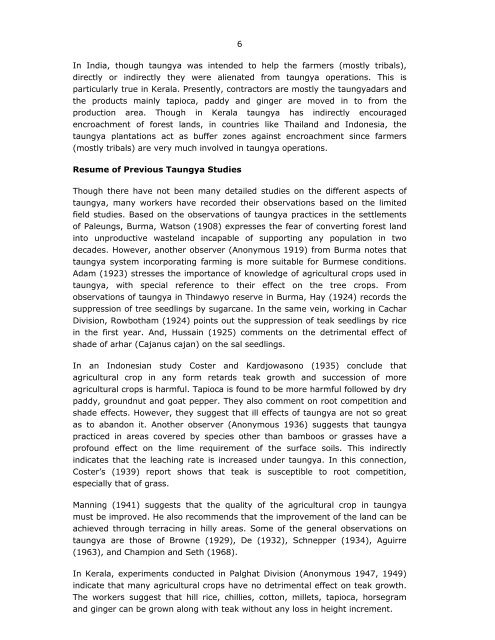taungya in relation to soil properties soil erosion and soil management
taungya in relation to soil properties soil erosion and soil management
taungya in relation to soil properties soil erosion and soil management
You also want an ePaper? Increase the reach of your titles
YUMPU automatically turns print PDFs into web optimized ePapers that Google loves.
6In India, though <strong>taungya</strong> was <strong>in</strong>tended <strong>to</strong> help the farmers (mostly tribals),directly or <strong>in</strong>directly they were alienated from <strong>taungya</strong> operations. This isparticularly true <strong>in</strong> Kerala. Presently, contrac<strong>to</strong>rs are mostly the <strong>taungya</strong>dars <strong>and</strong>the products ma<strong>in</strong>ly tapioca, paddy <strong>and</strong> g<strong>in</strong>ger are moved <strong>in</strong> <strong>to</strong> from theproduction area. Though <strong>in</strong> Kerala <strong>taungya</strong> has <strong>in</strong>directly encouragedencroachment of forest l<strong>and</strong>s, <strong>in</strong> countries like Thail<strong>and</strong> <strong>and</strong> Indonesia, the<strong>taungya</strong> plantations act as buffer zones aga<strong>in</strong>st encroachment s<strong>in</strong>ce farmers(mostly tribals) are very much <strong>in</strong>volved <strong>in</strong> <strong>taungya</strong> operations.Resume of Previous Taungya StudiesThough there have not been many detailed studies on the different aspects of<strong>taungya</strong>, many workers have recorded their observations based on the limitedfield studies. Based on the observations of <strong>taungya</strong> practices <strong>in</strong> the settlementsof Paleungs, Burma, Watson (1908) expresses the fear of convert<strong>in</strong>g forest l<strong>and</strong><strong>in</strong><strong>to</strong> unproductive wastel<strong>and</strong> <strong>in</strong>capable of support<strong>in</strong>g any population <strong>in</strong> twodecades. However, another observer (Anonymous 1919) from Burma notes that<strong>taungya</strong> system <strong>in</strong>corporat<strong>in</strong>g farm<strong>in</strong>g is more suitable for Burmese conditions.Adam (1923) stresses the importance of knowledge of agricultural crops used <strong>in</strong><strong>taungya</strong>, with special reference <strong>to</strong> their effect on the tree crops. Fromobservations of <strong>taungya</strong> <strong>in</strong> Th<strong>in</strong>dawyo reserve <strong>in</strong> Burma, Hay (1924) records thesuppression of tree seedl<strong>in</strong>gs by sugarcane. In the same ve<strong>in</strong>, work<strong>in</strong>g <strong>in</strong> CacharDivision, Rowbotham (1924) po<strong>in</strong>ts out the suppression of teak seedl<strong>in</strong>gs by rice<strong>in</strong> the first year. And, Hussa<strong>in</strong> (1925) comments on the detrimental effect ofshade of arhar (Cajanus cajan) on the sal seedl<strong>in</strong>gs.In an Indonesian study Coster <strong>and</strong> Kardjowasono (1935) conclude thatagricultural crop <strong>in</strong> any form retards teak growth <strong>and</strong> succession of moreagricultural crops is harmful. Tapioca is found <strong>to</strong> be more harmful followed by drypaddy, groundnut <strong>and</strong> goat pepper. They also comment on root competition <strong>and</strong>shade effects. However, they suggest that ill effects of <strong>taungya</strong> are not so greatas <strong>to</strong> ab<strong>and</strong>on it. Another observer (Anonymous 1936) suggests that <strong>taungya</strong>practiced <strong>in</strong> areas covered by species other than bamboos or grasses have aprofound effect on the lime requirement of the surface <strong>soil</strong>s. This <strong>in</strong>directly<strong>in</strong>dicates that the leach<strong>in</strong>g rate is <strong>in</strong>creased under <strong>taungya</strong>. In this connection,Coster’s (1939) report shows that teak is susceptible <strong>to</strong> root competition,especially that of grass.Mann<strong>in</strong>g (1941) suggests that the quality of the agricultural crop <strong>in</strong> <strong>taungya</strong>must be improved. He also recommends that the improvement of the l<strong>and</strong> can beachieved through terrac<strong>in</strong>g <strong>in</strong> hilly areas. Some of the general observations on<strong>taungya</strong> are those of Browne (1929), De (1932), Schnepper (1934), Aguirre(1963), <strong>and</strong> Champion <strong>and</strong> Seth (1968).In Kerala, experiments conducted <strong>in</strong> Palghat Division (Anonymous 1947, 1949)<strong>in</strong>dicate that many agricultural crops have no detrimental effect on teak growth.The workers suggest that hill rice, chillies, cot<strong>to</strong>n, millets, tapioca, horsegram<strong>and</strong> g<strong>in</strong>ger can be grown along with teak without any loss <strong>in</strong> height <strong>in</strong>crement.

















